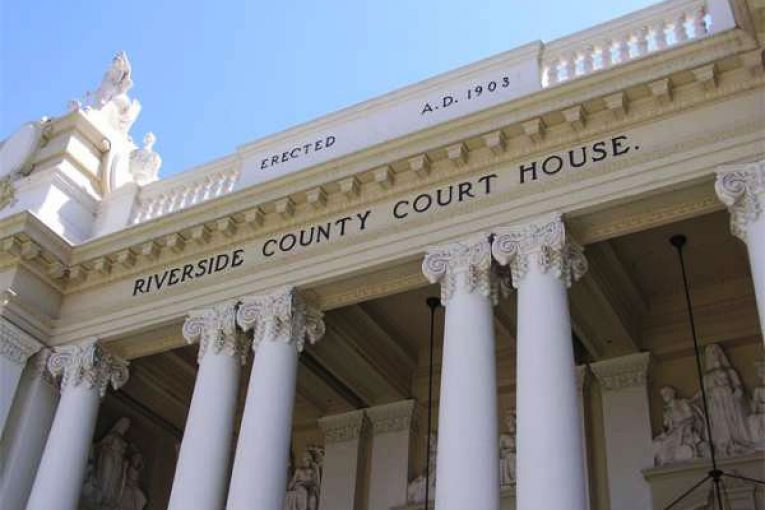

By Mihajla Milovanovic and Talia Kruger
RIVERSIDE, CA- The jury trial here in Riverside Superior Court Wednesday for Moses Daniel Olaez and his brother Manuel Sandoval Olaez proceeded with strong testimony and jailhouse evidence regarding their alleged gang affiliation.
The first deputy put on the stand described Moses’ physical appearance including chest tattoos that he had claimed were not affiliated with the gang. The deputy explained that Olaez was arrested by another deputy along with two other men and charged with possession of drugs. He added he knew who Moses was before his arrest through previous encounters.
Defense Attorney James Boyd then began his questioning about the gangs in the area, most of them coming from Los Angeles and spreading to San Diego, including “The Crypts,” and “The Coors.”
The deputy confirmed that his encounter with Moses was on Jan. 4, 2017, and at the time of this encounter, there were shotgun shells found on him. He also stated the two men in Moses’ car, including his brother, were “associated with the gang.”
The deputy stated to the courtroom that there is a difference between being a “member” and an “associate” to the gang, and he classified Moses’ brother as an “associate.”
The deputy also added that near the time of the encounter in January, Moses was wearing a hat that said “shyboy” on it and that they believed it was his moniker.
The next witness worked with the Riverside County Sheriff’s Gang Investigation Unit at the time of his encounter with Moses.
Evidence was then brought to the stand for the witness to see and he explained that he filled out an identification card for Moses’ Facebook account that “was relevant” to him. The Facebook picture was a red flag for him because of the “individuals that he was with and at the time, the symbols he was making with his hands, as well as his tattoos.”
The picture was also said to have Moses holding up the letter “H” meaning that he owned the city of Hemet, California, with his gang. He mentioned that at this point they had evidence to believe Moses was a part of the “La Raza” gang, because he was in contact with the leader, Juan Martinez.

The investigator wrote another identification card for Moses in Hemet, where Moses was simply walking around his neighborhood. The investigator explained that at the time, he had a felony warrant and was then arrested.
He also added that the tattoo on Moses’ head was also a red flag because it was of the St. Louis Major League Baseball team, which gangs commonly tattoo themselves “as symbols to represent their gangs.” Moses also had “Hemet” tattooed on his forearm, as similarly seen in the Facebook picture.
Following recess, an investigator was called to the stand and questioned by the prosecution as to what a “roll call sheet” and a “kite” was, and the significance of these items in the jails he had worked in.
The investigator explained that a roll call sheet was a record filled out by Hispanic inmates in jails and prisons, that would list each inmate’s name, booking number, what they were charged with, if they had a gang affiliation, and when their next hearing date was.
These roll call sheets were to be passed secretly between different housing units and facilities so that “shot-callers” could spread information as a mode to uphold prison politics and gang solidarity.
A mode of secretly passing these notes was to send them in the form of “kites” which were small pieces of paper that inmates would hide in their bodies and transport to different facilities when they were moved for hearings.
The deputy testified that each individual inmate would write their name and affiliation (if any) and it was unlikely that someone would ever put someone else’s name down with an affiliation for fear of upsetting the politics of prison and putting themselves in danger.
Next, the deputy was instructed to describe a kite he had intercepted at the time in which Moses was in the jail, which was entered as evidence for the trial.
According to the deputy, the message at the top of the paper stated “CTR (con todo respecto (with all my respect)), this is Jesse from Corona 4th St. sending my regards and an update from housing unit G. Nano the previous shot-caller got moved so now I’m the shot-caller and I’m sending a roll call of the homies. Send a huila (kite) if you need to get anything from me.”
Under this message in several columns was the roll call sheet for housing unit G. This role call sheet was signed with Moses Olaez, the moniker “Mo,” and listed next to his name was affiliation with the Hemet 13 gang, and that he was a Southsider.
Also on that list was the name of one of the men Moses Olaez had allegedly been with at the time the murder took place. Hemet 13 gang and Southsider were also listed next to his name.
Following this witness, the prosecution called recess for the day and the trial will reconvene in Riverside County Department 2F.